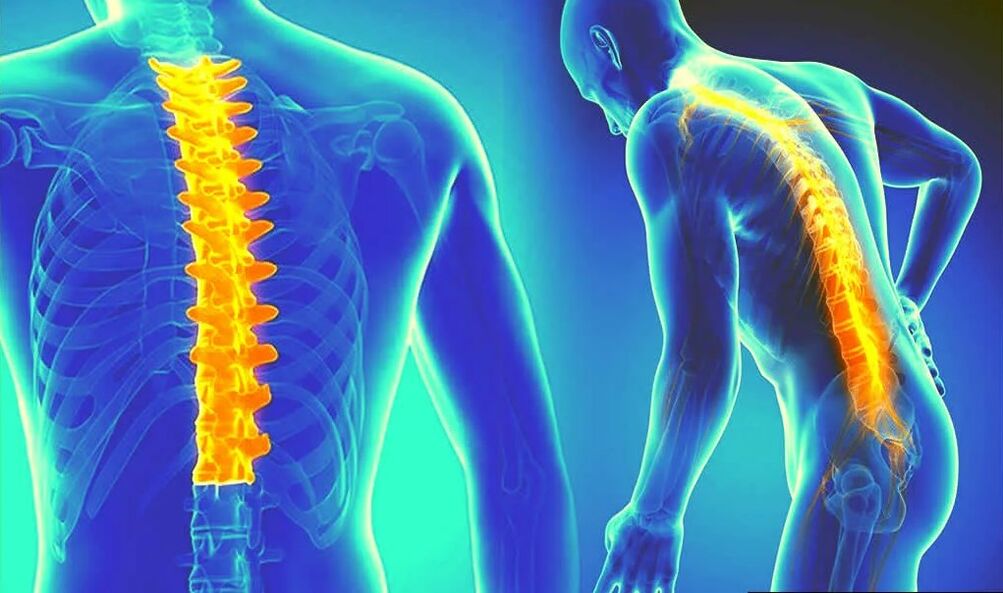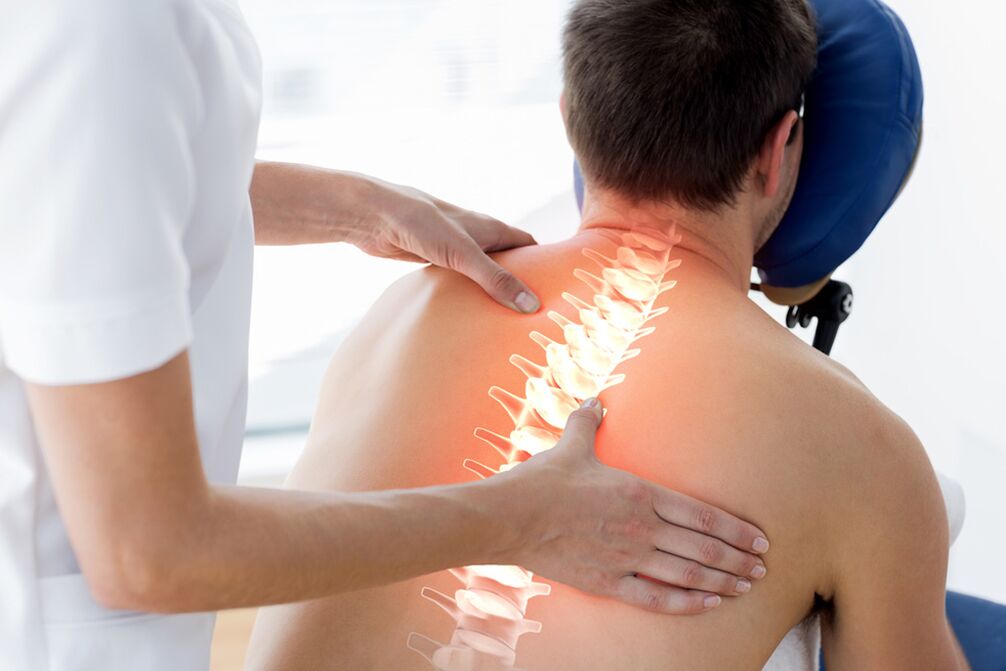Osteochondrosis is called a pathological process in the cartilage of the intervertebral disc and nearby tissues. The disease can occur in any part of the spine, but the cervical spine is more prone to osteochondrosis. This is due to the anatomical characteristics of the body. The vertebrae of the neck are smaller than the vertebrae of the thoracic and lumbar spine and are very close to each other. In addition, the neck is characterized by increased mobility and regular pressure when holding the head.

Why does this disease occur
The development of the disease is mainly related to age. Pay attention to other reasons:
- Lack of physical exercise;
- Spinal diseases;
- Excessive overload
- Improper posture
- Unfavorable inheritance;
- Weight gain
- An autoimmune disease in which cartilage is damaged.
Nutrition seriously affects the condition of bone and cartilage tissue. A diet lacking calcium, phosphorus, zinc, magnesium, vitamins A and E, and vitamin D will promote the development of pathology. High-risk groups include office workers, professional athletes and people engaged in manual labor.
How to identify cervical osteochondrosis
The symptoms of the disease depend on the clinical situation and the stage of development. The most common signs are:
- Not only affects the neck and head, but also affects pain in other parts of the body;
- Weakness, reduced hand sensitivity, numbness of the face;
- The tightening of the neck when the head needs to be turned;
- Dizziness, weakness and darkening of eyes caused by vasoconstriction;
- Vision and hearing loss.
The pain of cervical osteochondrosis plagues almost all patients. Through pathological examination, the blood vessels of the nerve ending bundles in the neck are constricted. Usually, the pain is most likely to be felt in the head, back pillow, and shoulder areas, and it spreads to the shoulder cap bones and chest.
In the context of this disease, the heart rhythm may be disturbed. In the neck, there are several arteries responsible for the blood supply to the brain. When blood vessels are squeezed, patients will face problems such as impaired motor coordination, arrhythmia and ischemic heart disease. In severe cases, blocked blood circulation can lead to strokes and other life-threatening conditions.
Stage of disease
The disease progression is divided into four stages:
- In the initial stage, bone and cartilage tissue have just begun to decompose. The pathological manifestations are mild pain and fatigue, and the patient is related to stress.
- In the second stage, the discs are reduced and cracks appear. Pain worsens, facial numbness and reduced sensitivity of limbs may occur.
- In the third stage, an intervertebral hernia begins to form. This process affects muscles and blood vessels. Not only will the patient feel pain, but also dizziness.
- In the final stage, bone tissue growth occurs and nerve endings are clamped. The disease manifests itself with obvious symptoms: pain, dizziness, numbness. Many patients have impaired exercise capacity.
Diagnostic procedure
If you suspect cervical osteochondrosis, you need to consult a neurologist and make a diagnosis. Its task is to assess the condition of bone and cartilage tissue. In the past, X-rays were used to diagnose spinal diseases. Now, more advanced research methods are preferred:
- CT scan;
- Nuclear magnetic resonance;
- Double scan of cervical spine vessels.
Usually, the doctor will prescribe comprehensive diagnostic information. It allows you to determine the presence and location of the hernia, the speed of blood flow, and the presence of obstacles to normal blood circulation.
treatment
Patients who are diagnosed with cervical osteochondrosis need to reconsider their lifestyle, ensure regular physical exercise and correct diet. In order to improve the condition, it is recommended to sleep on an orthopedic mattress and comfortable pillows to reduce the pressure on the spine.
medical treatement
Patients with cervical osteochondrosis can see drugs that reduce inflammation, improve blood flow, and relieve pain. The doctor prescribed vasodilators, muscle relaxants, non-steroidal anti-inflammatory drugs, drugs to improve cerebral circulation, and chondroprotectants-a method to restore cartilage tissue. In order to slow down the aging of bone tissue, the human body needs B vitamins, calcium, phosphorus, magnesium, and niacin.
physiotherapy

Physical therapy is the main method to treat cervical osteochondrosis. Experts use many procedures whose task is to improve the metabolic processes of bone and cartilage tissue, relieve pain, relieve cramps and improve blood circulation. The following are the basic techniques:
- Shock wave therapy. . . low-frequency sound waves affect the cartilage of the cervical spine. They help the recovery of tissues and slow down the formation of osteophytes-the growth of bones can squeeze nerve endings and blood vessels. The source of low-frequency waves is a special device, so SWT courses can only be conducted in medical institutions.
- massage. . . This is the most common method for conservative treatment of cervical osteochondrosis. Massage helps to improve blood circulation and relieve muscle spasms. The technique of therapeutic massage is selected according to the stage of the disease and the clinical situation. This is a very important condition, because if massage is performed unprofessional, it may harm the patient and cause deterioration of health. It is worth giving up massage for treating vascular diseases and high blood pressure. During the aggravation period, the massage should be as delicate as possible. Allow touching, rubbing, that is, hitting the upper layer of tissue.
- Gymnastics therapy (exercise therapy). . . Exercise therapy helps strengthen muscles and improve blood circulation. There are special exercises for patients with osteochondrosis. Gymnastics can be performed not only in the office of a medical institution, but also at home. Generally, exercise therapy is the most effective during the period of relief when the patient does not have severe pain. Healthy exercise should be combined with walking and drinking routines.
- acupuncture. . . This is an auxiliary method for the treatment of osteochondrosis, which is based on the effect of specifically targeting biologically active points. Therefore, the metabolism is activated and the pain syndrome is reduced.
- Exercise therapy. . . This is a hardware technology used to treat spinal diseases and recover from injuries. Thanks to these exercises, the burden on the spine is reduced, mobility is improved, and blood circulation is restored. The exercise therapy course is conducted under the guidance of the instructor. There are many exercise methods and equipment, so choose a suitable set of exercises for each patient.
- Laser therapy. . . Thanks to the laser radiation, positive results have been achieved and the patient's health has been improved. The procedure reduces inflammation and pain, and has a positive effect on metabolic processes.
- electrotherapy. . . The equipment used by experts is a source of electric current, pulses, and alternating current. The purpose of this procedure is to relieve pain, relieve cramps and irritation.
- Water program. . . Water is the best medicine for treating osteochondrosis. Patients suffering from this disease need therapeutic baths, swimming, and underwater massages. Regular visits to the swimming pool are very useful for preventing and treating pathology.
Osteochondrosis surgery
Spine surgery for osteochondrosis is suitable for patients with advanced disease. In this case, conservative methods cannot be relieved. Surgery is used to remove herniated discs and affected discs. In addition, surgery is performed to enlarge the diameter of the spinal canal and remove the vertebral arch. Their goal is to eliminate the compression of the nerves and spinal cord, so you can get rid of discomfort.
All operations are performed under anesthesia using X-rays and microsurgery.
For herniated discs, laser discectomy is used. This is a minimally invasive technique that allows you to use a laser beam to evaporate the nucleus pulposus of the intervertebral disc, thereby eliminating compression.
Nutrition for osteochondrosis
Improper nutrition increases the risk of degenerative dystrophy of the skeletal and muscular system (including osteochondrosis). In order to slow down the pathological process of bones and cartilage, it is necessary to provide the human body with adequate amounts of vitamins and minerals. The diet should include:
- Dairy products-a source of calcium;
- Fresh vegetables and herbs;
- Beans, nuts, seeds-source of protein, magnesium, B vitamins;
- Grains, baked goods with added whole grains;
- Lean meat;
- Fish and seafood;
- Olive oil and other vegetable oils;
- Jelly, jelly meat, jelly dishes.
There are no strict dietary restrictions, but some foods should not be consumed in large amounts. First of all, it is strong tea and coffee, which will impair the absorption of calcium and vitamins. High-salt foods will not help.























